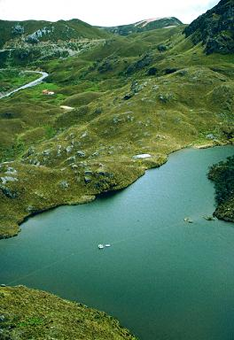NOAA/WDS Paleoclimatology - Kiang Co, Tibetan Plateau, China 950 Year Particle Size and XRF Data
This archived Paleoclimatology Study is available from the NOAA National Centers for Environmental Information (NCEI), under the World Data Service (WDS) for Paleoclimatology. The associated NCEI study type is Lake. The data include parameters of paleolimnology with a geographic location of China, Eastern Asia. The time period coverage is from 891 to -57 in calendar years before present (BP). See metadata information for parameter and study location details. Please cite this study when using the data.
- Cite as: Conroy, J.L.; Overpeck, J.T.; Cole, J.E.; Liu, K.-B.; Wang, L.; Ducea, M.N. (2014-03-05): NOAA/WDS Paleoclimatology - Kiang Co, Tibetan Plateau, China 950 Year Particle Size and XRF Data. [indicate subset used]. NOAA National Centers for Environmental Information. https://doi.org/10.25921/76pk-jb67. Accessed [date].
- Please refer to Credit tab for full citation information.
- doi:10.25921/76pk-jb67
- noaa-lake-16136
- NCEI DSI 1200_02
- NCEI DSI 1200_01
noaa-lake-16136
| Search Data |
|
| Download Data |
|
| Distribution Formats |
|
| Ordering Instructions | Contact NCEI for other distribution options and instructions. |
| Distributor | NOAA National Centers for Environmental Information
ncei.info@noaa.gov |
| Dataset Point of Contact | NOAA National Centers for Environmental Information
ncei.info@noaa.gov |
| Dataset Point of Contact | Data Center Contact
NOAA World Data Service for Paleoclimatology 828-271-4800 paleo@noaa.gov |
| Coverage Description | Date Range: 1059 CE to 2007 CE; Date Range: 891 cal yr BP to -57 cal yr BP; |
| Time Period | 1059 to 2007 |
| Spatial Bounding Box Coordinates |
N: 30.55
S: 30.55
E: 81.74
W: 81.74
|
| Spatial Coverage Map | |
| General Documentation |
|
| Associated Resources |
|
| Publication Dates |
|
| Data Presentation Form | Digital table - digital representation of facts or figures systematically displayed, especially in columns
|
| Dataset Progress Status | Complete - production of the data has been completed |
| Data Update Frequency | Data update frequency not available |
| Supplemental Information |
STUDY NOTES: Proxy record of dust on the Tibetan Plateau for the past ~1000 years. Data are high resolution lake sediment measurements from Kiang Co, including particle size classes and elemental abundances measured by scanning X-ray fluorescence (XRF). XRF element data include Al, Si, Cl, K, Ca, Ti, Mn, Fe, Zn, Rb, and Sr. The particle size record consists of 65 individual time series of volume percent abundance for particle sizes ranging from 0.27-0.31 um to 1905-2000 um.
ABSTRACT SUPPLIED BY ORIGINATOR: Dust over the Himalayas and southern Tibetan Plateau may influence high-elevation temperature and hydrology across Asia, but little is known about long-term dust variability and its relationship with regional climate over the last millennium. Here we have reconstructed a proxy record of past dust and temperature impacts on glacial streamflow and sediment deposition in Kiang Co, a small lake on the southwestern Tibetan Plateau. Terrigenous elemental variability in the Kiang Co sediment record, a proxy for glaciofluvial sediment deposition in the lake, covaries with the Dasuopu ice core dust record from the central Himalayas on centennial timescales. The relationship between the Kiang Co sediment record and Dasuopu indicates coherent dust forcing across the central Himalayas over much of the last millennium, and suggests that regional dustiness influences glacial streamflow and sediment transport on centennial timescales. In addition, the Kiang Co terrigenous elemental abundance record is positively correlated with May-September temperatures from the Tibetan Plateau to central India from 1870 to 2007 AD, highlighting the important influence of temperature on melting and streamflow in this region, as well as a relationship between dust and temperature on centennial timescales. These findings strengthen the likelihood of future dustiness with continued warming, along with further increases in melting and high-elevation streamflow in coming decades. |
| Purpose | Records of past climate and environment derived from lake sediment records. Parameter keywords describe what was measured in this dataset. Additional summary information can be found in the abstracts of papers listed in the dataset citations. |
| Dataset Citation |
|
| Cited Authors |
|
| Originators |
|
| Publishers |
|
| Theme keywords | Global Change Master Directory (GCMD) Science Keywords
|
| Data Center keywords | Global Change Master Directory (GCMD) Data Center Keywords
|
| Place keywords |
|
| Use Constraints |
|
| Access Constraints |
|
| Fees |
|
Last Modified: 2023-09-01
For questions about the information on this page, please email: ncei.info@noaa.gov
